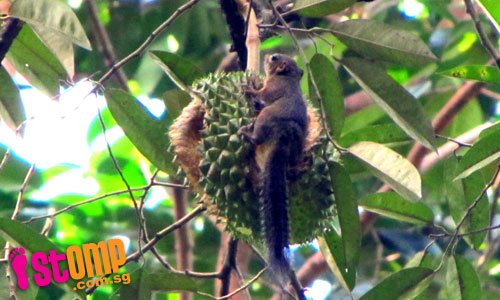
STOMPer seaeagle spotted squirrels and monkeys feeding on durians at the Bukit Batok Nature Park.
Said the STOMPer:
"Squirrels and monkeys love our local durians too!
"When you visit Bukit Batok Nature Park, you can spot them.
"Just watch out for the sign that reads, 'falling durians'."
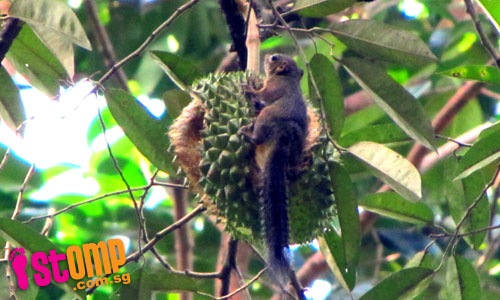
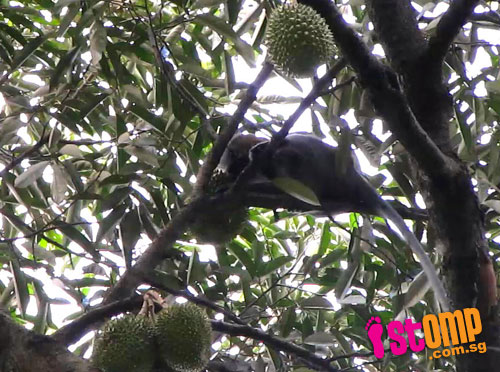
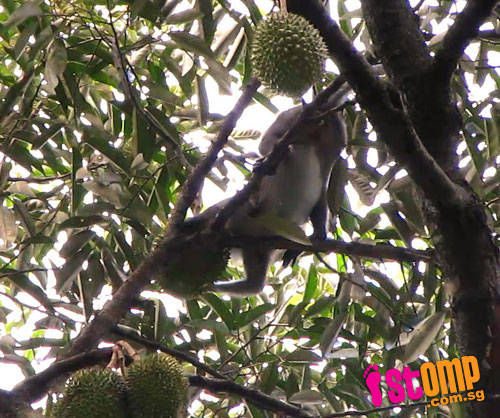
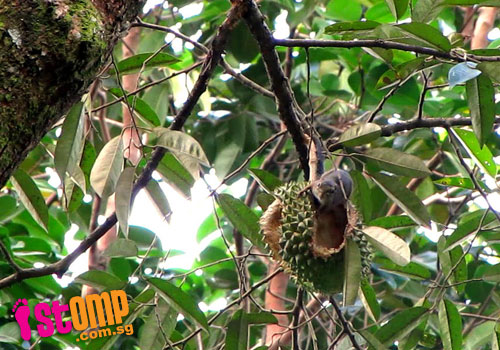
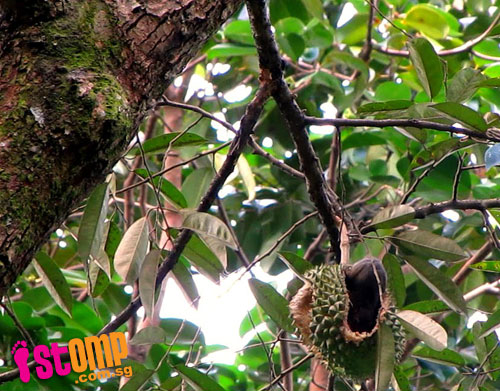
It's obvious that humans are not the only mammals that love durians (Durio spp.); these photos clearly show that plantain squirrels (Callosciurus notatus) and long-tailed macaques (Macaca fascicularis) also feed on the so-called King of Fruits. On Pulau Ubin, wild boar (Sus scrofa) are also attracted to durian trees during the fruiting season.
Once the hard and thorny husk has been breached, smaller animals are able to gain access to the flesh within. Here in Singapore, various birds have been observed pecking at durians which have been gnawed open by squirrels.
Elsewhere in tropical Southeast Asia, durians are the targets of other large mammals; orangutans (Pongo spp.) are especially fond of durian.
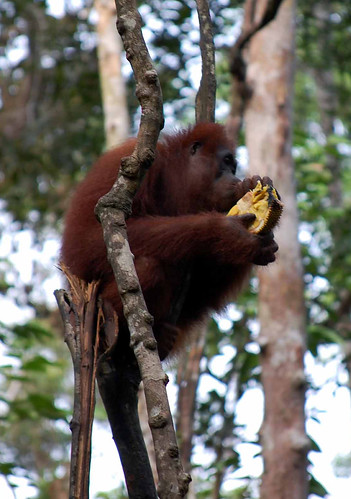
Bornean orangutan (Pongo pygmaeus) feeding on durian, Sarawak;
(Photo by owenelias)
Durians are also eaten by carnivorans such as civets and sun bear (Helarctos malayanus).
Even the tiger (Panthera tigris), which is strictly carnivorous, is said to feed on durian.
In the process of feeding, large mammals often end up swallowing the seed alongside with the flesh. The seed passes through the digestive system and eventually ends up somewhere else in the forest (hopefully some distance away from the parent plant), along with a nice little pile of fertiliser. Sometimes, the seed is simply spat out or regurgitated. In the case of rodents, seeds may be buried or hoarded away as part of a cache, providing opportunities for them to germinate. Hence, many mammals, from mice to elephants, fulfill an important role in the dispersal of the seeds of many rainforest plants. For instance, according to ecologist Richard Corlett, large herbivores such as elephants and rhinoceros are thought to be the major dispersal agents for mango (Mangifera spp.).
Perhaps the most important consumers of durians are the megaherbivores, such as the Asian elephant (Elephas maximus). These giants supposedly swallow the fruit whole, thorns and all, and are able to disperse seeds across great distances, given how far an elephant can travel in a single day.
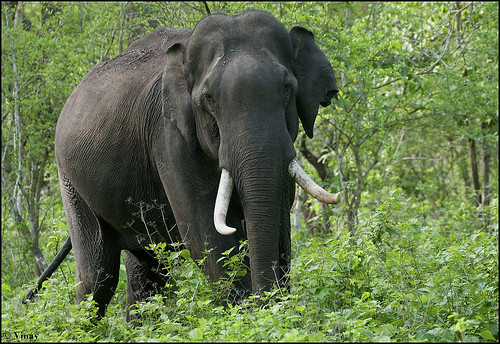
Elephants are keystone species in the forests of Africa and Asia, dispersing the seeds of numerous plants;
(Photo by Vinay Narayana Swamy)
However, durians and many other fruit trees in Southeast Asia are losing important dispersal agents, due to habitat loss and hunting. Elephants have few ecological equivalents in terms of their ability to disperse the seeds of plants that produce large fruits. The Javan rhinoceros (Rhinoceros sondaicus) and Sumatran rhinoceros (Dicerorhinus sumatrensis) have been wiped out from most parts of their former range. That leaves a final megaherbivore, the Malayan tapir (Tapir indicus), although research done on captive tapirs suggests that compared to elephants, they are less effective dispersers of large seeds.
In forests where elephants, rhinoceros, and tapir are now absent, pigs and deer are left to take on the role of seed dispersal. Unfortunately, they make even poorer replacements; pigs have a tendency to crack open seeds, while deer destroy or damage a lot of seeds with vigorous chewing.
Even plants which depend on large aerial dispersers such as fruit bats, fruit pigeons, and hornbills are at risk, due to populations being decimated by hunting and deforestation.
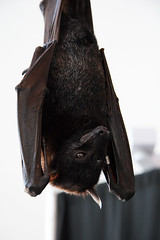
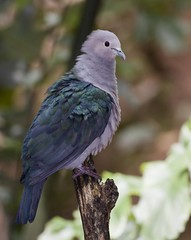
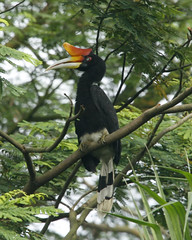
The Malayan flying fox (Pteropus vampyrus), green imperial pigeon (Ducula aenea) and rhinoceros hornbill (Buceros rhinoceros) were former residents in Singapore; today, the flying fox and imperial pigeon are occasional visitors from neighbouring countries, and the hornbill is locally extinct.
(Photos by littleREDelf, jonclark2000 and Lip Kee respectively)
The loss of these dispersers does not bode well for many forests in Southeast Asia, including Singapore, where trees may remain standing for centuries, yet without any recruitment of seedlings due to a lack of seed dispersal. Hence these species may turn out to be the 'living dead', since there are no new individuals sprouting up to replace the mature trees that die. A lack of dispersal also means that there is no gene flow between different populations; in a world where forests are increasingly being fragmented and cut off from one another by human development, this renders populations vulnerable to local extinction due to inbreeding, or lack of recruitment.
Instead of having seeds scattered far and wide, fruits simply fall to the ground and rot in the shade of the parent tree, or are consumed by animals that lack the capacity to transport the seeds over great distances. Squirrels and parrots are typically seed predators, destroying many seeds and rendering them nonviable. Macaques tend to spit out seeds while consuming fruit, although some may be stored in the cheek pouches and dropped some time later. Here in Singapore, the return of the Oriental pied hornbill (Anthracoceros albirostris) might help restart the dispersal of many species, although there is the question of whether this frugivore is able to tackle large seeds routinely handled by the rhinoceros hornbill. Seed dispersal in Asian forests has been a topic of study for Richard Corlett, who has shared about this in a couple of public talks in 2007 and 2008.
In the American tropics, where the largest extant mammals are tapirs, there are several examples of tree species bearing fruit which are not being effectively dispersed by any native species today. This has led some ecologists to postulate that these trees were adapted to have their seeds dispersed by now-extinct megafauna. During the Pleistocene, much of Central and South America was inhabited by large herbivores such as ground sloths and relatives of elephants known as gomphotheres, with these species becoming extinct by 11,000 years ago, possibly due to climate change, human hunting, or a combination of these 2 factors.


Reconstructions of 2 extinct herbivores of tropical Central and South America: the gomphothere Stegomastodon platensis and the giant ground sloth Eremotherium laurillardi.
(Gomphothere drawn by Edwin O.Y. Chávez, sloth taken from Jchistory)
The Pleistocene megafaunal extinctions of the Americas took place relatively recently in geological time, leaving behind a variety of plants which might have once relied on these megaherbivores to disperse their seeds. These plants, among others, have been termed 'evolutionary anachronisms', possessing adaptations for a partnership that has been gone for at least 11,000 years.

Evolutionary anachronisms form the premise of a book called The Ghosts of Evolution: Nonsensical Fruit, Missing Partners, and Other Ecological Anachronisms, showcasing a variety of plant species which might have once been dispersed by gomphotheres, sloths, and other extinct megafauna of the Americas. The author, Connie Barlow, makes a compelling case for the hypothesis first proposed in a 1982 paper by Daniel Janzen and Paul Martin. Today, many of these plants manage to persist due to their ability to propagate asexually, or because their fruits are now being eaten and their seeds dispersed by human beings and introduced domestic livestock.
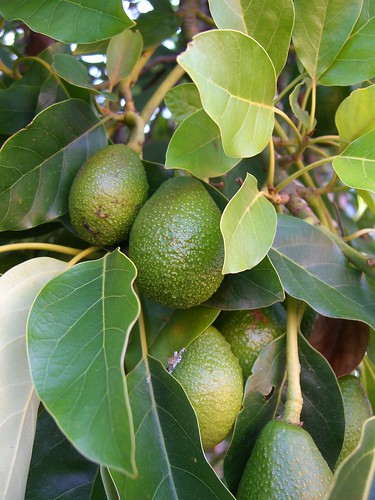
One plant which might have been adapted to be dispersed by extinct megafauna, but which now flourishes thanks to humans is the avocado (Persea americana);
(Photo by avlxyz)
While Southeast Asia did not suffer the widespread mass extinction of its megafauna seen in the Americas, it can be argued that such an event is taking place now, with the extensive deforestation and hunting that is seeing numerous species vanish from their former haunts. Even if the forests are spared, the loss of the seed dispersers may see an eventual decline and loss of plant diversity. Hopefully, with sound conservation measures and legislation to help maintain critical protected habitat for species such as rhino and elephant, we can help ensure that some of these vital interactions between plants and herbivores may be maintained, instead of going the way of the gomphothere.